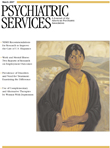March 2007: This Month's Highlights
Two Studies of Employment Outcomes
The critical role of gainful employment in community integration of individuals with serious mental illness has received renewed attention since publication of the President's New Freedom Commission's report in 2003. Two studies in this month's issue examine factors related to employment in this population. David S. Salkever, Ph.D., and colleagues examined data from the U.S. Schizophrenia Care and Assessment Program (US-SCAP), a naturalistic study of more than 2,300 participants randomly selected from organized care systems in six U.S. regions. Data on employment were gathered at more than 7,000 assessments over three years. The overall employment rate in nonsheltered jobs was 17.2%. Rates of attaining a recovery threshold of employment—defined as 40 hours of work per month—were even lower at 9.7%. The mean monthly wage among those who worked was $494 ( Original article: page 315 ). The second study examined outcomes of a supported employment program implemented at nine Veterans Affairs (VA) medical centers for homeless veterans with mental disorders, substance use disorders, or both. Robert A. Rosenheck, M.D., and Alvin S. Mares, Ph.D., found that over two years program participants showed better work outcomes than veterans in a comparison group. Days competitively employed per month were 15% higher (8.4 days compared with 7.3 days), and average annualized employment income was about $1,300 higher ($8,889 compared with $7,590) ( Original article: page 325 ). In a commentary on the VA study, Gary R. Bond, Ph.D., warns that accepting marginal improvements is setting the bar too low and notes that we can do better ( Original article: page 334 ).
Assessing Treatment Need
Epidemiologic studies estimate the prevalence of mental disorders in the population. However, prevalence estimates are not an ideal proxy for treatment need. Need for treatment is not simply a function of diagnosis. In a study reported by Erick Messias, M.D., Ph.D., and colleagues, population estimates of need for treatment were based on direct assessments by psychiatrists of treatment need in a subsample of 816 participants in the original Epidemiologic Catchment Area study in Baltimore who were followed up more than 12 years later. On the basis of these assessments, the estimated population prevalence of the need for treatment was 28.7%. The greatest need was for treatment for alcohol dependence, followed by major depression, social phobia, panic disorder, and agoraphobia ( Original article: page 373 ). In a related Taking Issue, Benjamin G. Druss, M.D., M.P.H., discusses the complexity of defining need for mental health treatment ( Original article: page 295 ).
Research and the U.S. Hispanic Population
Increased recognition of disparities in treatment for ethnic minority groups has spurred new research. Sandy M. Magaña, Ph.D., M.S.W., and coauthors report on a study of psychological distress among 85 Latino family caregivers of adult relatives with schizophrenia. Forty percent of the caregivers met criteria for depression, which was significantly related to caregivers' perceived burden and stigma ( Original article: page 378 ). Another report summarizes recommendations of a consensus panel of 15 senior researchers convened by the National Institute of Mental Health (NIMH). The panel members identified research issues in five broad areas that they deemed most pertinent for improving treatment for Hispanic individuals with persistent mental disorders ( Original article: page 385 ). The summary report is accompanied by a commentary by Thomas R. Insel, M.D., director of NIMH, who emphasizes the need to create a more equitable and responsive system to address the needs of all who enter it ( Original article: page 395 ).
Complementary and Alternative Therapies
Many studies have documented high rates of use of complementary and alternative medicine to treat physical and mental disorders. Use of such therapies is increasingly common among Americans with depression. Ping Wu, Ph.D., and colleagues focused on the use of three types of such therapies—manual therapies (such as chiropractic treatment and massage), herbs, and vitamins—in a nationally representative sample of 220 women with depression. Fifty-four percent of the women reported use of at least one of these therapies in the past year ( Original article: page 349 ). In a study conducted by Lin Fang, Ph.D., and Steven P. Schinke, Ph.D., at a community mental health center, 82% of 153 Chinese Americans were found to be currently using some form of alternative therapy ( Original article: page 402 ).
Briefly Noted …
• A literature review examines current theories about how to change clinicians' behavior ( Original article: page 342 ).
• Is the treatment alliance affected when a clinician is also a representative payee ( Original article: page 365 )?
• Formulary coverage of major classifications of psychotropic drugs by Medicare Part D prescription drug plans is examined in the Economic Grand Rounds column ( Original article: page 308 ).



